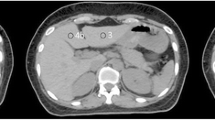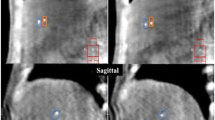Abstract
Purpose
The purpose of this study was to analyze the respiratory motion of each segment of the liver in patients with or without a history of abdominal surgery using four-dimensional computed tomography.
Materials and methods
In total, 57 patients treated for abdominal tumors using proton beam therapy were enrolled. Eighteen patients had a history of abdominal surgery and 39 did not. The positions of clearly demarcated, high-density regions in the liver were measured as evaluation points with which to quantify the motion of each liver segment according to the Couinaud classification.
Results
In total, 218 evaluation points were analyzed. Comparison of differences in the motion of individual liver segments showed that among patients without a history of surgery, the maximum was 29.0 (7.2–42.1) mm in S6 and the minimum was 15.1 (10.6–19.3) mm in S4. Among patients with a history of surgery, the maximum was 28.0 (9.0–37.4) mm in S7 and the minimum was 6.3 (4.1–9.3) mm in S3.
Conclusion
The distances and directions of respiratory motion differed for each liver segment, and a history of abdominal surgery reduced the respiratory motion of the liver. It is necessary to selectively use the internal margin setting.



Similar content being viewed by others
References
World Health Organization. World Cancer Report 2014. pp. 403-412 Chapter 5.6. ISBN 9283204298. http://publications.iarc.fr/Non-Series-Publications/World-Cancer-Reports/World-Cancer-Report-2014 Accessed August 1, 2017.
World Health Organization. World Cancer Report 2014. pp. 16-53 Chapter 1.1. ISBN 9283204298. http://publications.iarc.fr/Non-Series-Publications/World-Cancer-Reports/World-Cancer-Report-2014 Accessed August 1, 2017.
Takeda A, Sanuki N, Tsurugai Y, Iwabuchi S, Matsunaga K, Ebinuma H, et al. Phase 2 study of stereotactic body radiotherapy and optional transarterial chemoembolization for solitary hepatocellular carcinoma not amenable to resection and radiofrequency ablation. Cancer. 2016;122:2041–9. https://doi.org/10.1002/cncr.30008.
Takeda A, Sanuki N, Tsurugai Y, Oku Y, Aoki Y. Stereotactic body radiotherapy for patients with oligometastases from colorectal cancer: risk-adapted dose prescription with a maximum dose of 83–100 Gy in five fractions. J Radiat Res. 2016;57:400–5. https://doi.org/10.1093/jrr/rrw029.
Mizumoto M, Okumura T, Hashimoto T, Fukuda K, Oshiro Y, Fukumitsu N, et al. Proton beam therapy for hepatocellular carcinoma: a comparison of three treatment protocols. Int J Radiat Oncol Biol Phys. 2011;81:1039–45. https://doi.org/10.1016/j.ijrobp.2010.07.015.
Komatsu S, Fukumoto T, Demizu Y, Miyawaki D, Terashima K, Sasaki R, et al. Clinical results and risk factors of proton and carbon ion therapy for hepatocellular carcinoma. Cancer. 2011;117:4890–904. https://doi.org/10.1002/cncr.26134.
Suit H, Goldberg S, Niemierko A, Trofimov A, Adams J, Paganetti H, et al. Proton beams to replace photon beams in radical dose treatments. Acta Oncol. 2003;42:800–8. https://doi.org/10.1080/02841860310017676.
Coutrakon G, Bauman M, Lesyna D, Miller D, Nusbaum J, Slater J, et al. A prototype beam delivery system for the proton medical accelerator at Loma Linda. Med Phys. 1991;18:1093–9. https://doi.org/10.1118/1.596617.
Kirilova A, Lockwood G, Choi P, Bana N, Haider MA, Brock KK, et al. Three-dimensional motion of liver tumors using cine-magnetic resonance imaging. Int J Radiat Oncol Biol Phys. 2008;71:1189–95. https://doi.org/10.1016/j.ijrobp.2007.11.026.
Akino Y, Oh RJ, Masai N, Shiomi H, Inoue T. Evaluation of potential internal target volume of liver tumors using cine-MRI. Med Phys. 2014;41:111704. https://doi.org/10.1118/1.4896821.
Park JC, Kim JS, Park SH, Webster MJ, Lee S, Song WY, et al. Four dimensional digital tomosynthesis using on-board imager for the verification of respiratory motion. PLoS One. 2014;9:e115795. https://doi.org/10.1371/journal.pone.0115795.
Lee S, Yang DS, Choi MS, Kim CY. Development of respiratory motion reduction device system (RMRDs) for radiotherapy in moving tumors. Jpn J Clin Oncol. 2004;34:686–91. https://doi.org/10.1093/jjco/hyh125.
Onishi H, Kuriyama K, Komiyama T, Tanaka S, Ueki J, Sano N, et al. CT evaluation of patient deep inspiration self-breath-holding: how precisely can patients reproduce the tumor position in the absence of respiratory monitoring devices? Med Phys. 2003;30:1183–7. https://doi.org/10.1118/1.1570372.
Takamatsu S, Takanaka T, Kumano T, Mizuno E, Shibata S, Ohashi S, et al. Reproducibility of diaphragm position assessed with a voluntary breath-holding device. Jpn J Radiol. 2013;31:357–63. https://doi.org/10.1007/s11604-013-0199-3.
Dawson LA, Eccles C, Bissonnette JP, Brock KK. Accuracy of daily image guidance for hypofractionated liver radiotherapy with active breathing control. Int J Radiat Oncol Biol Phys. 2005;62:1247–52. https://doi.org/10.1016/j.ijrobp.2005.03.072.
Underberg RW, Lagerwaard FJ, Slotman BJ, Cuijpers JP, Senan S. Benefit of respiration-gated stereotactic radiotherapy for stage I lung cancer: an analysis of 4DCT datasets. Int J Radiat Oncol Biol Phys. 2005;62:554–60. https://doi.org/10.1016/j.ijrobp.2005.01.032.
Ohara K, Okumura T, Akisada M, Inada T, Mori T, Yokota H, et al. Irradiation synchronized with respiration gate. Int J Radiat Oncol Biol Phys. 1989;17:853–7. https://doi.org/10.1016/0360-3016(89)90078-3.
Tsunashima Y, Vedam S, Dong L, Umezawa M, Sakae T, Bues M, et al. Efficiency of respiratory-gated delivery of synchrotron-based pulsed proton irradiation. Phys Med Biol. 2008;53:1947–59. https://doi.org/10.1088/0031-9155/53/7/010.
Shirato H, Shimizu S, Kunieda T, Kitamura K, van Herk M, Kagei K, et al. Physical aspects of a real-time tumor-tracking system for gated radiotherapy. Int J Radiat Oncol Biol Phys. 2000;48:1187–95. https://doi.org/10.1016/S0360-3016(00)00748-3.
Weibel MA, Maino G. Peritoneal adhesions and their relation to abdominal surgery. A postmortem study. Am J Surg. 1973;126:345–53. https://doi.org/10.1016/S0002-9610(73)80123-0.
ten Broek RP, Issa Y, van Santbrink EJ, Bouvy ND, Kruitwagen RF, Jeekel J, et al. Burden of adhesions in abdominal and pelvic surgery: systematic review and met-analysis. BMJ. 2013;347:f5588. https://doi.org/10.1136/bmj.f5588.
Quatromoni JC, Rosoff L, Halls JM, Yellin AE. Early postoperative small bowel obstruction. Ann Surg. 1980;191:72–74. https://www.ncbi.nlm.nih.gov/pmc/articles/PMC1344621/pdf/annsurg00227-0086.pdf. Accessed August 1, 2017.
Menzies D, Elis H. Intestinal obstruction from adhesions–how big is the problem? Ann R Coll Surg Engl. 1990;72:60–63. https://www.ncbi.nlm.nih.gov/pmc/articles/PMC2499092/pdf/annrcse01560-0064.pdf. Accessed August 1, 2017.
ten Broek RP, Stommel MW, Strik C, van Laarhoven CJ, Keus F, van Goor H. Benefits and harms of adhesion barriers for abdominal surgery: a systematic review and meta-analysis. Lancet. 2014;383:48–59. https://doi.org/10.1016/S0140-6736(13)61687-6.
Hallman JL, Mori S, Sharp GC, Lu HM, Hong TS, Chen GT. A four-dimensional computed tomography analysis of multiorgan abdominal motion. Int J Radiat Oncol Biol Phys. 2012;83:435–41. https://doi.org/10.1016/j.ijrobp.2011.06.1970.
Kumagai M, Mori S. Movement of a small tumour in contact with the diaphragm: characterisation with four-dimensional CT. Jpn J Radiol. 2016;34:154–7. https://doi.org/10.1007/s11604-015-0509-z.
Fernandes AT, Apisarnthanarax S, Yin L, Zou W, Rosen M, Plastaras JP, et al. Comparative assessment of liver tumor motion using cine-magnetic resonance imaging versus 4-dimensional computed tomography. Int J Radiat Oncol Biol Phys. 2015;91:1034–40. https://doi.org/10.1016/j.ijrobp.2014.12.048.
Gabryś D, Kulik R, Trela K, Ślosarek K. Dosimetric comparison of liver tumour radiotherapy in all respiratory phases and in one phase using 4DCT. Radiother Oncol. 2011;100:360–4. https://doi.org/10.1016/j.radonc.2011.09.006.
Liu Y, Jin R, Chen M, Song E, Xu X, Zhang S, et al. Contour propagation using non-uniform cubic B-splines for lung tumor delineation in 4D-CT. Int J Comput Assist Radiol Surg. 2016;11:2139–51. https://doi.org/10.1007/s11548-016-1457-5.
Feng Z, Li A, Gong H, Luo Q. An automatic method for nucleus boundary segmentation based on a closed cubic spline. Front Neuroinform. 2016;10:21. https://doi.org/10.3389/fninf.2016.00021.
Eccles CL, Patel R, Simeonov AK, Lockwood G, Haider M, Dawson LA. Comparison of liver tumor motion with and without abdominal compression using cine-magnetic resonance imaging. Int J Radiat Oncol Biol Phys. 2011;79:602–8. https://doi.org/10.1016/j.ijrobp.2010.04.028.
Hu Y, Zhou YK, Chen YX, Shi SM, Zeng ZC. 4D-CT scans reveal reduced magnitude of respiratory liver motion achieved by different abdominal compression plate positions in patients with intrahepatic tumors undergoing helical tomotherapy. Med Phys. 2016;43:4335. https://doi.org/10.1118/1.4953190.
Nishioka T, Nishioka S, Kawahara M, Tanaka S, Shirato H, Nishi K, et al. Synchronous monitoring of external/internal respiratory motion: validity of respiration-gated radiotherapy for liver tumors. Jpn J Radiol. 2009;27:285–9. https://doi.org/10.1007/s11604-009-0332-5.
Acknowledgements
We gratefully acknowledge the work of the members of the Proton Therapy Center at Fukui Prefectural Hospital as well as the staff of the Radiology Department at Kanazawa University for their understanding and support.
Funding
This research did not receive any specific grant from funding agencies in the public, commercial, or not-for-profit sectors.
Author information
Authors and Affiliations
Corresponding author
Ethics declarations
Conflicts of interest
We declare no actual or potential conflicts of interest.
Ethical statement
This retrospective study was approved by the research ethics committee of our institution.
Electronic supplementary material
Below is the link to the electronic supplementary material.
About this article
Cite this article
Shimizu, Y., Takamatsu, S., Yamamoto, K. et al. Segmental analysis of respiratory liver motion in patients with and without a history of abdominal surgery. Jpn J Radiol 36, 511–518 (2018). https://doi.org/10.1007/s11604-018-0750-3
Received:
Accepted:
Published:
Issue Date:
DOI: https://doi.org/10.1007/s11604-018-0750-3




